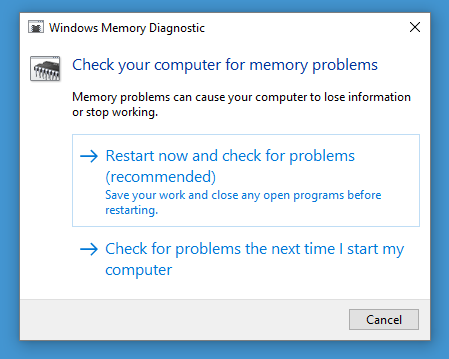This post is from Help with BSOD, just as a reply of mine to that question.
Perhaps your stick(s) of memory loosed.
Since manufacturing qualities are not good enough, will lead to some old mainboards' memory sockets easy to loose; once when it was shook by some external forces, it will loose.
A variety of possible forces will cause this loose, maybe by other person (such as your family in home or your colleague in company), maybe just by yourself, accidentally, foot kicked the computer case, or, elbow or knee hit the computer case, will lead to
the stick(s) of memory loose.
Please open the computer case, press the both sides of a memory socket to eject a stick of memory, then re-insert it into socket again, one by one,
reseat all of the sticks of memory.
Certainly, your stick(s) of memory might really occur physical corruption.
Therefore, you should check whether your memory is bad.
Type or paste "MdSched" in the Cortana's search box, and then tap or click on the words which reveal on the Cortana's pop-up parts:
Windows Memory Diagnostic
Desktop app
then the Windows Memory Diagnostics Tool is running.
Please click on "Restart now and check for problems (recommended)", then restart your computer.
If the windows error reporting tell you that the faults of blue screen of death you met are caused by many different reasons, I suggest that the troubleshooting order should be as follows:
Memory -> CPU clock setting -> CPU fan -> Mainboard chipset -> Network adapter card -> Video card -> Sound card -> Hard disk
-> Whether do you installed more than one anti-virus softwares or anti-malware tools? Are there any conflicts between them? Sometimes an anti-malware tool from informal channel itself just is malicious...
-> Perform clean boot, delete scheduled tasks, restore system health, scan viruses & malwares, and so on.
You are responsible for ensuring that the operating system you are using is a clean, safe, stable and healthy system, so please do what you should do (related operations include perform clean boot, delete scheduled tasks, restore health, scan viruses, etc),
which is a good habit.
Press Win+X, A, Alt+Y to open a Command Prompt (Adimin) window.
As my thread -
Perform a clean boot in Windows 10
Run the following batch file in Command Prompt (Adimin) window to perform a clean boot:
CleanBoot.bat
reg delete HKEY_LOCAL_MACHINE\SOFTWARE\Microsoft\Windows\CurrentVersion\Run /va /f
reg delete HKEY_LOCAL_MACHINE\SOFTWARE\Wow6432Node\Microsoft\Windows\CurrentVersion\Run /va /f
reg delete HKEY_CURRENT_USER\SOFTWARE\Microsoft\Windows\CurrentVersion\Run /va /f
reg delete HKEY_USERS\S-1-5-19\SOFTWARE\Microsoft\Windows\CurrentVersion\Run /va /f
reg delete HKEY_USERS\S-1-5-20\SOFTWARE\Microsoft\Windows\CurrentVersion\Run /va /f
Run the following batch file in Command Prompt (Adimin) window to delete scheduled tasks:
DelSchTasks.bat
schtasks /Delete /TN * /F
Run the following batch file in Command Prompt (Adimin) window to restore system's health:
RestoreHealth.bat
sfc /scannow
dism /online /cleanup-image /restorehealth
Note:
If necessary, use the /Source argument of dism command to specify the Windows installation disc as the source that the files are restored only from the location in the optical disc drive where they are found, just perform as below:
dism /Online /Cleanup-Image /RestoreHealth /Source:WIM:X:\sources\install.wim:1 /LimitAccess
Where "X" is located to the drive letter of the optical disc drive, simply replace the "X" placeholder with the correct optical disc drive letter.
Refer to:
ZigZag3143's wiki article.
Then reboot the system.


